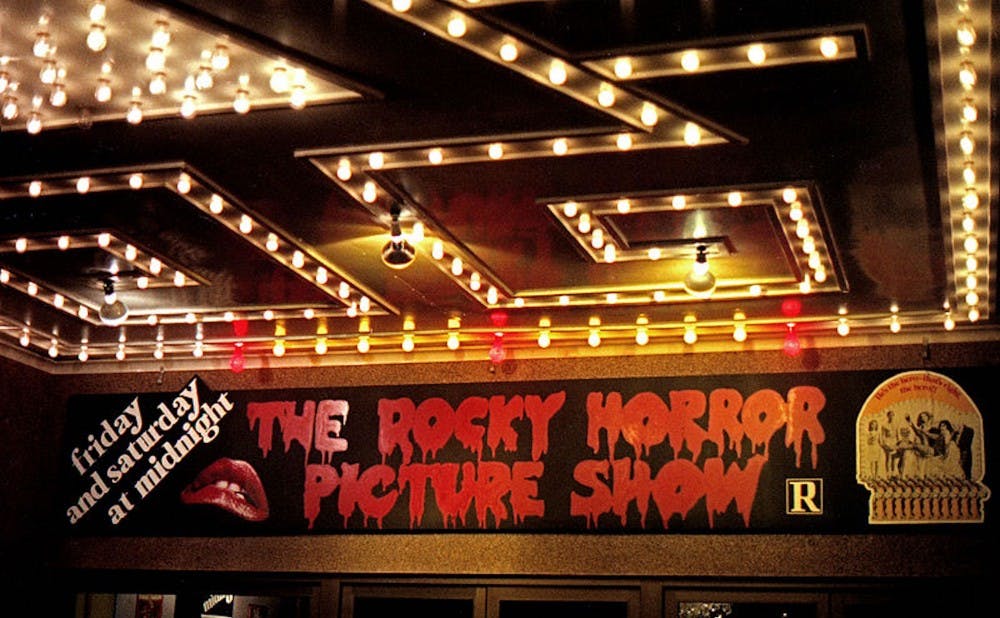I wiped a heavy smear of gold glitter across my left eyelid. It was the third of four varieties of glitter I would generously heap on my face during a fantastically untraditional getting-ready-to-go-out ritual on Saturday night. My curling iron burned on my desk next to a tube of lipstick I associate with dance competitions of yore. There was a lot to do in order to transform me —
make-up balking and physically unassuming — into a creature of the night, and I was having an absolute blast.
A devil, two cats and a boxer/Victoria’s Secret angel (?) stopped by my door on their way to Halloweekend Night Two festivities.
“Hey Tay, what are you going as?” The devil was trying to make sense of my strange semblance of fishnets, strappy black things and a feather boa.
“Umm … sexuality,” I offered.
“Freedom! Absolute liberation!” my RA — and date for the night — called from down the hall.
That freedom is what brings millions of lingerie-clad “The Rocky Horror Picture Show” worshippers to the annual Mecca of Halloween screenings. Cult classics like this offer fans identity and community outside the conventions of the mainstream.
And that’s what the night brought. From the drive down the pitch-black, winding highway to Hillsborough, singing “Sweet Transvestite” in voices louder and stranger than our own, to the warm and boisterous frenzy of nostalgic (albeit intoxicated) adults doing the Time Warp again.
In a dark taproom at Mystery Brewery, I melted into the wild energy of lifetime and accidental first-time “Rocky Horror” cult fanatics. Any inhibitions of conduct and speech we generally observe as civilized people were drowned out by the pop culture phenomenon’s unapologetic cocktail of sci-fi, sex and rock ‘n’ roll. We danced erratically and laughed unapologetically when the clever among us shouted well-timed obscenities.
The show was intimate. Local band The Wiley Fosters performed “Rocky Horror”’s beloved soundtrack live, while actors portraying its iconic personas took the stage or wandered through the crowd of audience members (who also, naturally, participated in the drama). Among the performers — friends and associates of The Little Green Pig Theatrical Concern — were Duke Theater Studies professors Jaybird O’Berski and Dana Marks, who played Dr. Frank N. Furter and Janet Weiss, respectively. O’Berski also serves as Artistic Director and Marks as Managing Director for Little Green Pig.
It was my first time experiencing “The Rocky Horror Picture Show” in the crowd-raging, sing-along, dressed-up-in-whatever setting it deserves, and I was proud to join the generations before me in the celebrated tradition of celebrating the film since its release in 1975. My mom could tell you the call-backs appropriate during “Dammit Janet.” I saw this experience as a rite of passage.
But unlike the “Rocky Horror” screening my friend had attended at his college campus the night before in lipstick redder than my own, this event didn’t even include the film. How does media become so iconic, so followed and adored, that it can give rise to a room full of costumed adults pelvic-thrusting to its soundtrack without the actual film playing a role in the festivities?
In the case of “Rocky Horror,” cult status was a factor of the film’s ideals. Nestled among the liberated spirit of social movements in the ‘70s, its message of uninhibited fulfillment carried on the winds of the times. And beyond the message, its artistry was new and provocative and its music lovable though a little too erotic for the mainstream — signs of cultural dissent that classically attract a cult fandom.
But there is no common factor that defines a cult classic. Fans love “A Clockwork Orange” for its striking social commentary and brave, unnerving images, and “The Princess Bride” for its timeless quotability. While neglect by mainstream media may make a film more worthy in the cult follower’s eyes, films like “Pulp Fiction” prove that a film can be both generally popular and achieve cult status. All it really takes is an attribute that stands out from the pack and enough noise made about it to accrue a following that lasts. In the case of Tommy Wiseau’s “The Room,” this stand-out attribute is plain, utter atrocity. On this facet alone, Wiseau’s cinematic disaster has become its own special genre of cult classic.
I got a taste of “The Room’s” growing fandom on Thursday night, when Duke University Union screened the film at Griffith Theater. DUU handed out t-shirts, plastic spoons and foam footballs at the door, which also acted as promotion devices for “The Disaster Artist,” a movie based on the tribulations that arose while filming “The Room.” DUU also hopes to screen “The Disaster Artist,” which hits theaters Dec. 1.
My experience with “The Room” was a derivative of cult fandom far separate from the wild jubilance of “Rocky Horror.” I spent most of the film’s duration half-hidden behind my friend in preparation for the torturously long, excruciatingly uncomfortable sex scenes that stud the film.
But, as with any cult classic, the camaraderie of the fandom was the dominant unifier. Plastic spoons and foam footballs rained down in simultaneous showers at the cues we knew well. We shouted, chanted, clapped. We, as the fans, were the living and interacting factor that rendered “The Room” as far more than a film.
Thus, the cult classic is humanoid; it is a culture that breathes through its members. And as its living parts succeed in generations, it lives on with them.
Get The Chronicle straight to your inbox
Signup for our weekly newsletter. Cancel at any time.

